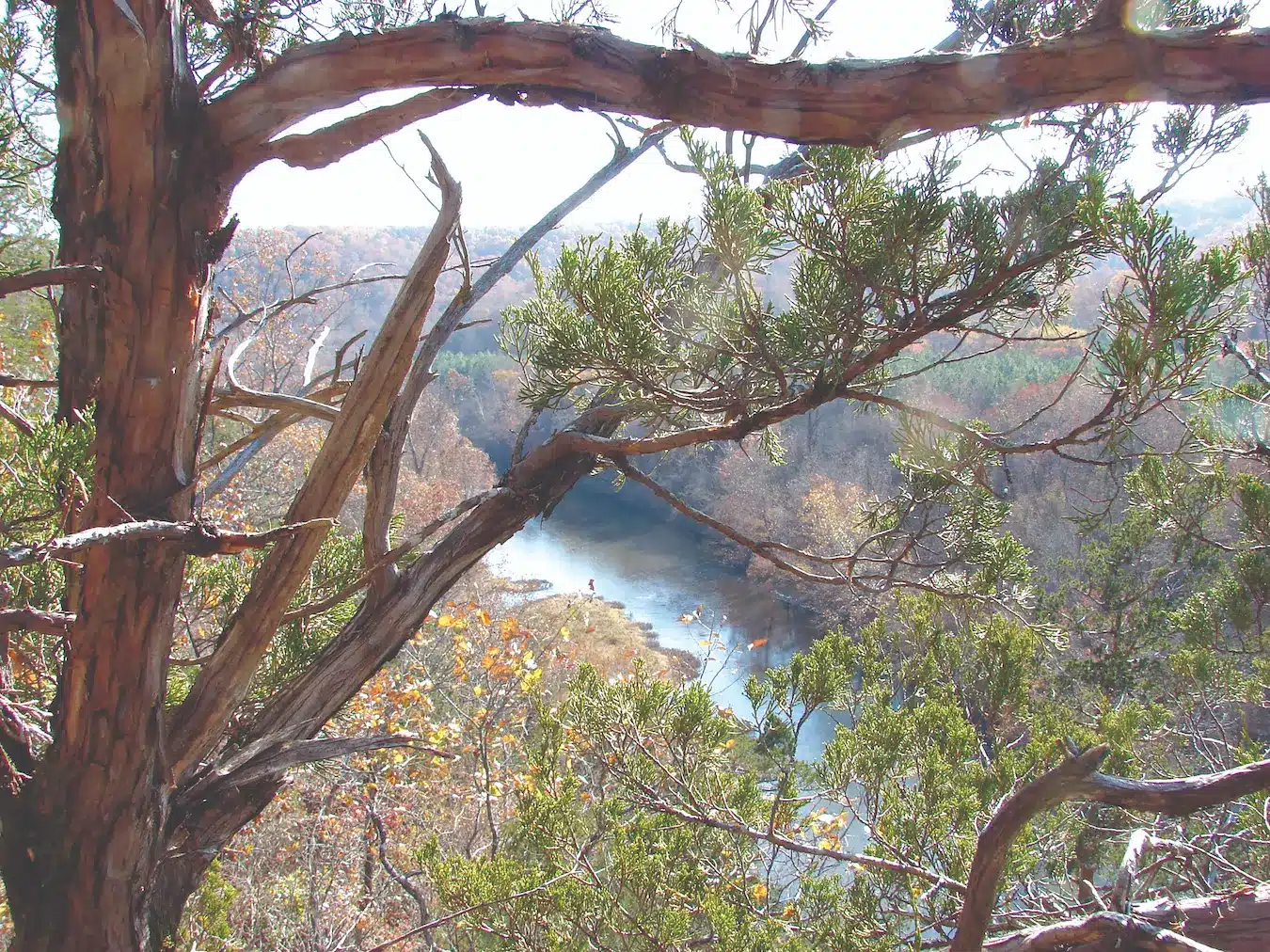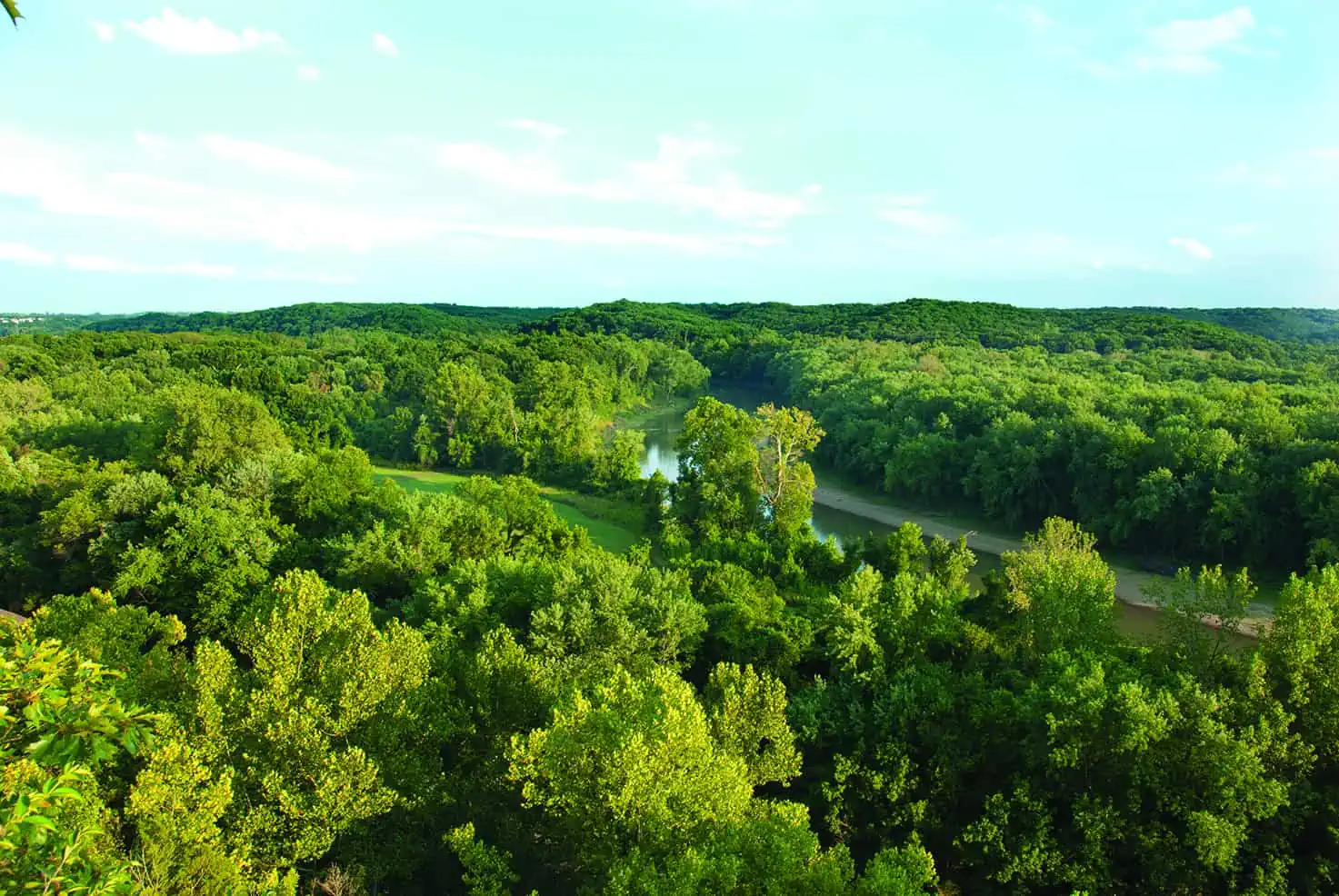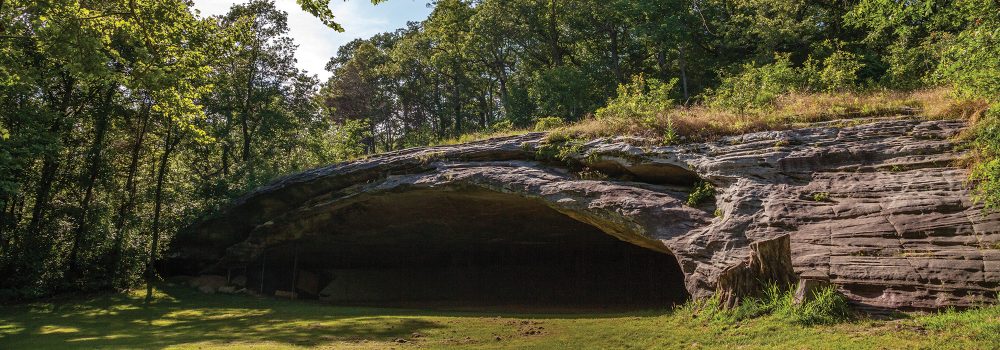Formed 50 millions years ago, this state park has geological treasures to share. Meander along one trail to see the flora of ten thousand years ago.
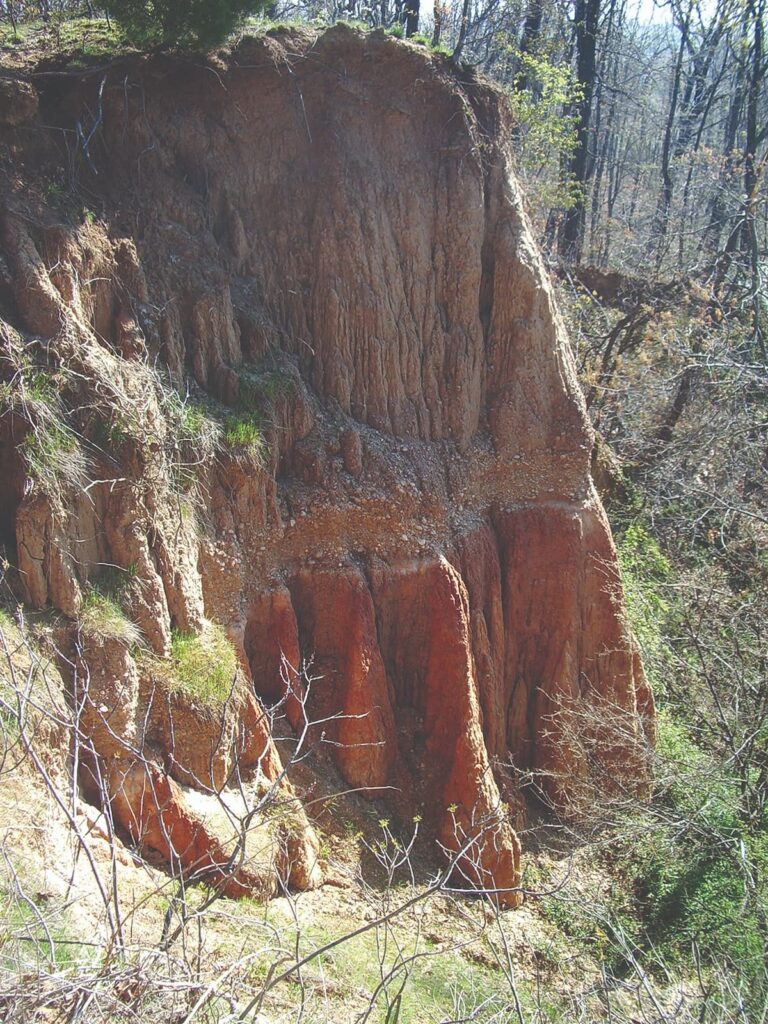
Photo by Chris Crabtree
ABOUT FIFTEEN MILES SOUTH OF CAPE GIRARDEAU on Interstate 55, a remarkable sight appears. Driving south through the rolling Benton Hills, there’s a big visual jolt upon reaching the crest of a moderate rise, where suddenly the whole earth spreads out before you. It turns out this last hill was small only on its north side. Once over the crest, there is a long downgrade, until the land is nearly totally flat in every direction. A first thought is that this is a river bottom, but it’s much too large. This is not just a river bottom; it’s a remnant of prehistoric delta land. Something like what happened in modern times a hundred miles south of New Orleans once happened here, about 50 million years ago.
Here in the heart of the continent, Gulf of Mexico waters once formed a huge bay that geologists call the Mississippi Embayment. It reached Missouri at its northwest edge. How this bay formed, filled in, eroded out, and left behind a bedrock, gravel, and soil spine several hundred feet high and some 150 miles long down its middle is a geological story both amazing and complex. That spine, known as Crowley’s Ridge, is a striking landscape feature of Missouri’s Bootheel region. On that ridge, a few miles east of Malden, is Morris State Park, a small but important remnant of this landscape. Jim D. Morris, a Springfield businessman who grew up picking peaches and cotton near Campbell four miles to the south, donated the land in 1999.
Geologists ascribe the formation of the embayment to plate tectonics, the means by which large plates of the earth’s crust, with continents riding on them, move slowly over the semi-liquid mantle far below. By this mechanism, continents are formed, split, reformed, and generally moved about. More than 700 million years ago, North America was nearly torn in half by tectonic forces. This “rift” did not succeed, but the attempt resulted in a sunken scar up the middle of the continent that was then filled with sediments that became rock. Reactivation of this rift, the Reelfoot Rift, during Cretaceous times around 100 million years ago, created a new lowland, which, combined with rising sea levels, allowed seawater from the Gulf of Mexico to pour into the depression and form the bay. This same rift failure, with its weakened rock structure or “fault” deep in the earth, was responsible for the notable New Madrid earthquakes of 1811 and 1812 and the ongoing seismic activity in this part of Missouri.
The bay was an ideal habitat for shallow, warm-water organisms, their exoskeletons gradually building up layers of calcareous clay, marl, and chalk on the bottom. At the same time, nearly two-thirds of what would become North America was draining into the embayment through precursors of great rivers yet to come. Delta formation by all these streams, large and small, gradually began to fill in the bay, building up layers of sand, gravel, and silt, mixed with the calcareous strata deposited by the marine organisms.
Then, about 34 million years ago, the seas retreated, draining the embayment, and the present coastline of the Gulf of Mexico began to materialize. During this time, sediments were eroded rather than deposited, until new deposits began forming less than five million years ago, before and during the last ice age. The river systems that had carried the sediments into the bottom of the bay continued processes we see today, alternately cutting away the materials they had earlier deposited and depositing new materials in turn. The great rivers of today began to form: the Mississippi, Missouri, Ohio, Arkansas, and many smaller ones meandered back and forth across the plain, cutting and depositing materials in the great central valley.
But one thing was very different in this last ice age period. The proto-Mississippi River stayed to the west side of the valley, while the Ohio kept to the east, not joining together until they finally met well within the boundary of present-day Louisiana. As the two rivers meandered back and forth, they often came within ten or twelve miles of meeting, but it just didn’t happen. Instead of one alluvial valley, two were formed, divided by this thin strip of elevated land between them. As the valleys eroded lower, the strip of land separating them became relatively higher. During glacial winters, when drought prevailed and monstrous windstorms swept the land, silt from the alluvial plain was swept up and later dropped as loess on the high ground of the ridge and on the bluff lines along the rivers, making the high spots even higher.

Photo by Wikipedian Kbh3rd
But this elevated strip between the rivers—Crowley’s Ridge—may not have been formed solely through erosion by the ancestral rivers. Geologists now think that earthquakes in the New Madrid Seismic Zone may have thrown up the ridge’s steep hillsides, called scarps. Earthquakes along the faults may have helped raise these parts of Crowley’s Ridge above the surrounding bedrock, now buried by sediments from the ancestral Mississippi and Ohio Rivers. Landslides along these steep hills, including one in Morris State Park, may be related to more recent earthquake activity.
The geologic story of Crowley’s Ridge was nearly complete, but there was one last act in the drama. More than ten thousand years ago, the Mississippi River finally did break through the ridge, near Cairo, Illinois.
Once through, it never returned to the west side. The Mississippi captured the Ohio River’s valley—and kept it—from Cairo all the way to the Gulf. Crowley’s Ridge was now an isolated cresting, some 150 miles long (partially in Missouri but mostly in Arkansas), a dozen miles wide, and rising several hundred feet above the alluvial plain, which bordered it on each side. Some miles to the east, the Mississippi-Missouri-Ohio combination flowed, and still flows, to the sea.
The bedrock, clays, and gravels that form Crowley’s Ridge have a wide range of geologic ages, varying from 600-million-year-old bedrock to silt that’s less than twenty thousand years old. The geologic sequence visible in Morris State Park begins with sandstones that formed in a delta environment, clays that were formed in a near-shore marine environment, and gravels left by the ancestral Mississippi and Ohio Rivers and their tributary streams. Some silt deposits are loess, wind-blown powdered rock left behind when the glaciers retreated.
So Morris State Park, a small one at 161 acres, has a big geologic story to tell. Although the park is small, it provides a pleasant and interesting visit. It nestles on the east flank of Crowley’s Ridge amongst surrounding peach orchards and is nearly all wooded. As a resource-preservation park, little development is planned; its main offering is a two-mile ramble on Beech Tree Trail.
The loop trail provides an accessible scenic overlook of the surrounding alluvial plain, but it is quite steep in places as it descends to the bottomland forest and then back up. In several spots, the sequential geologic strata that built the ridge are well displayed—or at least those of the last few hundred thousand years or so. And, there is a final surprise—a complement of trees and plants restricted to this region of Missouri.
Through some curious history and evolution, Crowley’s Ridge has acted as an island of refuge for plant communities that were more common in Missouri several thousand years ago, when the climate here was cooler and more moist. Did the alluvial, swampy ground on either side of the ridge inhibit the spread and domination of species from the Ozark hills? Whatever the cause, as at Trail of Tears State Park, the woods of Morris State Park more resemble the forests of the Appalachian Mountains than they do the Ozarks. The entire park is mature sand woodland, a rare natural community in Missouri largely confined to ancient escarpments, ridges, and dissected hills in the Mississippi alluvial plain, such as here
at Crowley’s Ridge. Most such sites have been extensively logged and converted to crops, pasture, or orchards, but here in Morris, there are still patches of old growth and remnants of the former Malden Prairie.
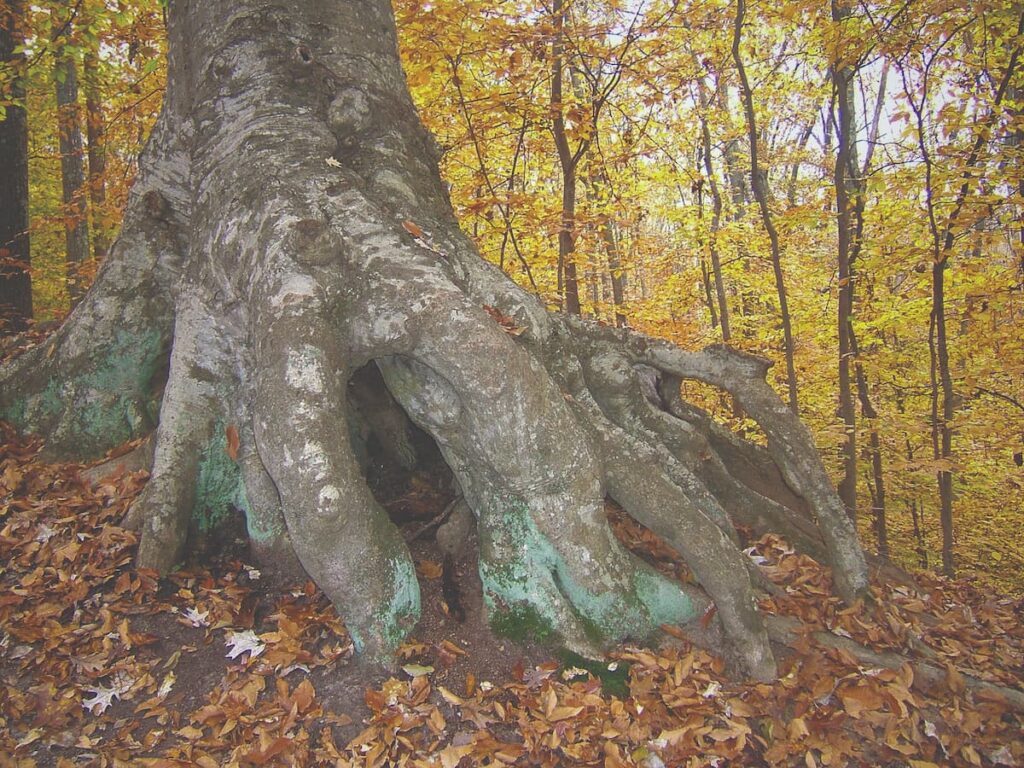
Photo by Allison Vaughn
Oaks, hickories, and cedars are here, to be sure, but tulip poplars, sweetgums, and American beeches also abound. In the understory are red buckeye and Hercules club, natives of the southeastern United States, along with some sedges and grasses not found in any other Missouri state park. The park has more than 325 species of plants, with many at the western or northern extent of their range. But in 2009, a huge ice storm nearly wiped out the park’s population of sweetgum trees, and the drought of 2012 killed many of the beeches. Perhaps Mother Nature isn’t quite done tinkering with her climate zone and plant range overlaps.
Of course, there is a more recent history to Crowley’s Ridge, beginning with extensive use by Native Americans and then its settlement in 1821 by Benjamin Crowley and others who followed, attracted by the deep, well-drained loess soils in an otherwise swampy region. American Indian traces, roads, and railroads followed the higher ground. A military road along the ridge moved troops engaged in the Civil War battles at Chalk Bluff a century and a half ago. In the park is the family cemetery of Jonas Stewart, a Confederate supporter from South Carolina, who was captured at Chalk Bluff and held at a Union encampment near or perhaps in what is now the state park. He became so enamored with the area that he returned with his family after the war to buy a farm and open a grist mill and a cotton gin.
But these are stories for another place and mere blinks of an eye in the geology embraced by Morris State Park, a park that tells the story of a time when this part of Missouri was oceanfront real estate, and where the flora of ten thousand years ago still persists.
Here in southeastern Missouri, waters of the Gulf of Mexico once lapped at the base of Ozark hills. A huge bay in Cretaceous times covered major portions of Louisiana, Arkansas, Mississippi, and Texas, as well as parts of Missouri, Kentucky, and Tennessee.

MORRIS STATE PARK • HIGHWAY WW, CAMPBELL
Read more about traveling in the bootheel of Missouri here.
Click here to purchase the Missouri State Parks and Historic Sites book.
Related Posts
The Diverse Current River State Park
The richly diverse Current River State Park has almost two miles of Current River frontage and a superb trail network. The fishing is abundant and a lazy float down the Current River is a perfect way to spend any day of the week.
Castlewood State Park
Castlewood State Park has more than thirty miles of hiking and biking trails, eleven of which are open to horseback riders. Experience the feel of a mature floodplain forest with its silver maple, box elder, black willow, white ash, sycamore, slippery elm, and hackberry. Bring a picnic and enjoy the beauty of this park.
Hiking Graham Cave State Park
Head over to Graham Cave State Park to walk in the footsteps of early Missourians.

